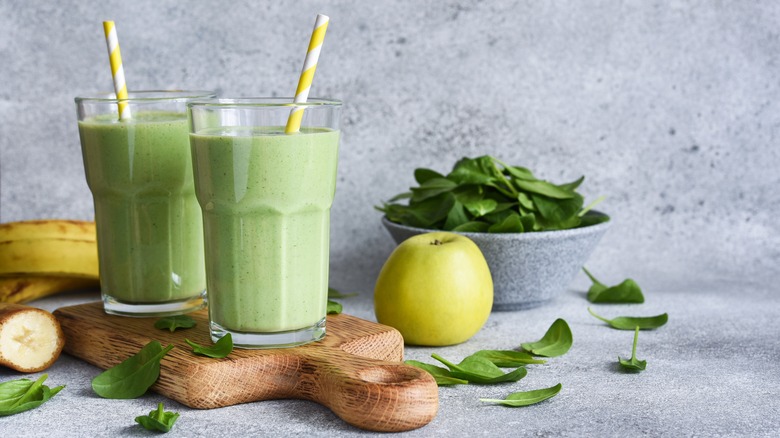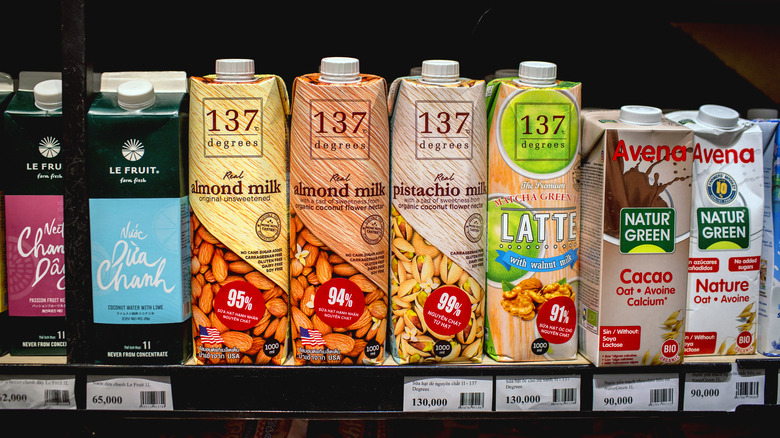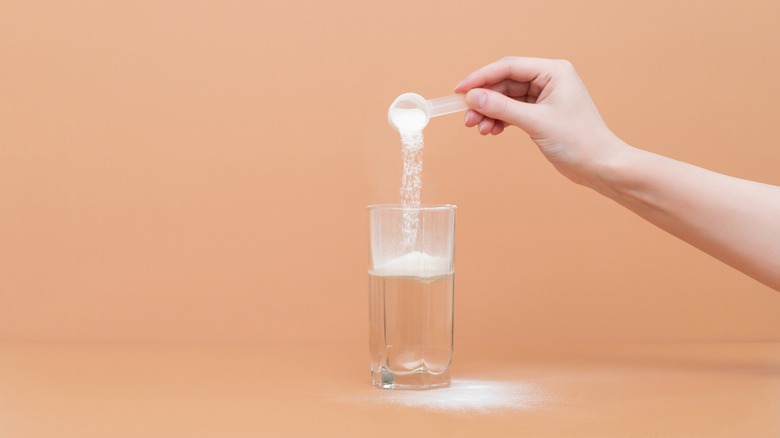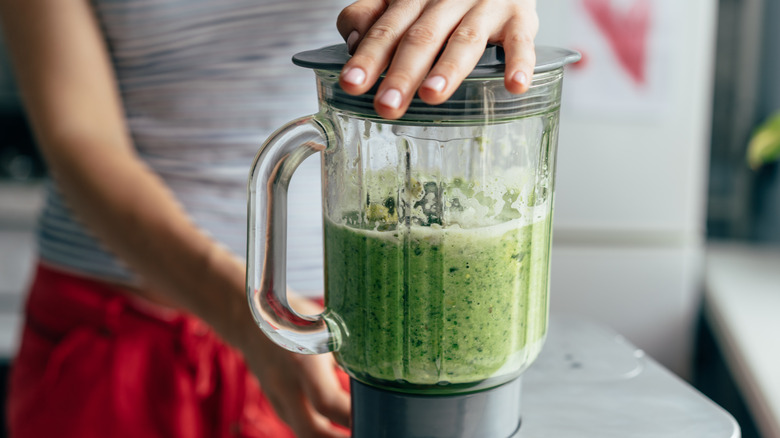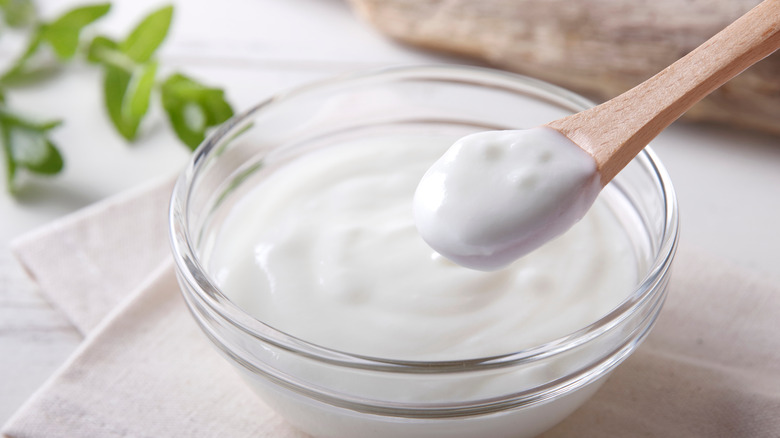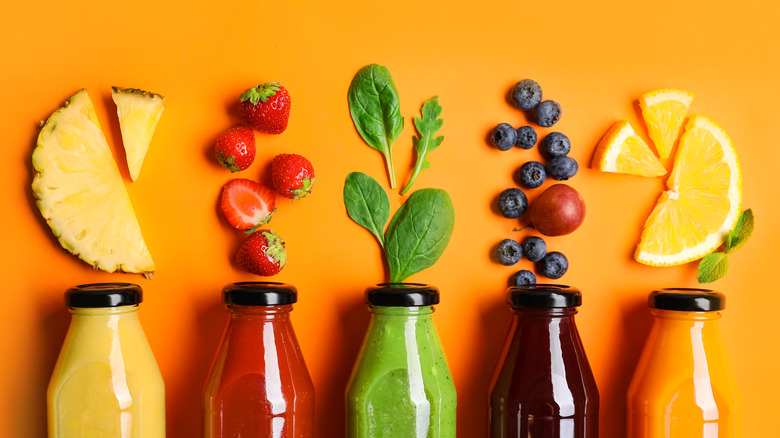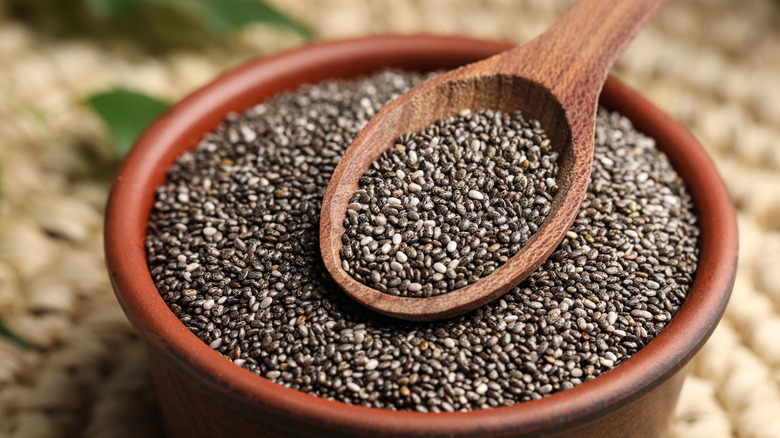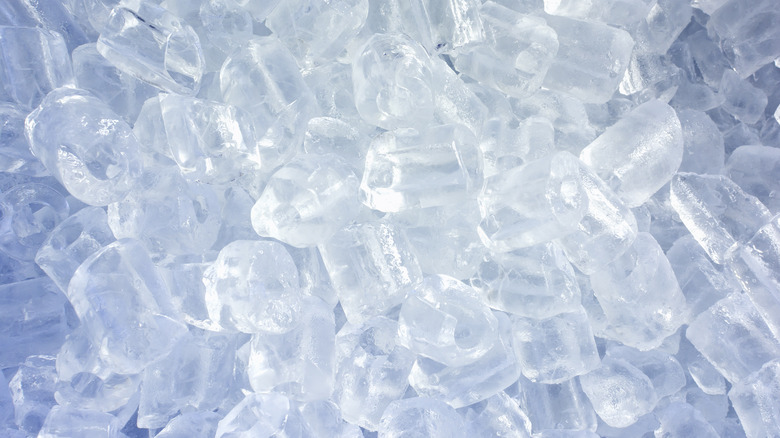A Beginner's Guide For How To Load Your Blender When Making A Smoothie
Some of us often ask ourselves how to improve our diets, and a go-to staple seems to be smoothies. They pepper our online feeds and tend to be the crown-jewel at juice bars and organic eateries. But, the "goodness" or healthiness of the smoothies largely depends on what we put into them. According to WebMD, it's the sum of all that goes into the drink that makes it worthwhile. Once you've got a healthy diet established, a healthy smoothie is pretty straightforward.
What can be difficult for some is how to blend a smoothie properly. With so many ingredients ranging from sweet to chalky to fibrous to potent, there are many ways to move a smoothie from delicious to disgusting. Thankfully, we're here to offer some tips to ensure the smoothie you're sipping on is absolutely perfect. Below is the order you should stack your smoothie ingredients before blending them to ensure the smoothest, most delicious, pour.
Liquids (base)
To properly blend the solid ingredients of a smoothie, you first need a liquid base to break them down. There are quite a few different options on hand: One intrepid poster on a cooking board on Stack Exchange asked whether it would be possible to make a smoothie with a water base. The consensus was yes, per the board, but why would you? After all, it would really dilute the rest of the drink. The Smoothie Bird has a few suggestions to start off your smoothie on the right foot, though it does concede that even water has its own place in the smoothie universe. For fruit concentrates and more strongly flavored smoothies, water will help dilute them. But, otherwise, there are better options. Coconut water, for example, does the same thing while adding a slightly coconut flavor and a bit of electrolytes and fiber.
Milk and milk alternatives aren't just for milkshakes. These will give home chefs a creamier fruit smoothie. Juice is a long-held popular option for smoothies, too, especially for green smoothies, as the sweet juice will help cut the stronger flavors of leafy greens that will be added. Just keep in mind that juices have quite a bit of sugar in them. For an interesting twist on a timeless classic, green tea will add a bunch of healthful nutrients to your smoothie, though like water, it won't add much flavor. It will, however, add some caffeine to your smoothie.
Powders
Protein shakes aren't only for gym bros. They have a plethora of benefits for anybody. But, for the sake of this article, we'll keep it simple when talking about the potential benefits of each individual ingredient. As per Medical News Today, protein powder is a source of dry protein that can aid in building and repairing muscles and help with weight loss. Protein powder isn't the tastiest ingredient on the list: Its flavor is sometimes described as "bitter" and "chalky." It certainly can't be eaten on its own and can really sour a smoothie if it's not properly blended in the recipe.
It's perfectly understandable that it would challenge even well-seasoned smoothie veterans. Experts over at ProteinPowder.com have a few suggestions on how to make a protein smoothie taste truly amazing. Firstly, avoid loading up with brands with artificial sweeteners as they'll overwhelm the smoothie and make it taste worse off. Secondly, the site notes that different protein powders have different textures. Whey-powder, which is based from cow's milk, is supposedly the creamiest option and should blend well into any smoothie. Whichever powder you choose to put in your smooothie, add it right after your liquid base.
Leafy greens
Green smoothies have really come into their own in pop-culture. They've simply become a symbol of a healthy and well-balanced diet. Whether or not this is completely true remains debatable, but one of the most crucial selling points is that they're nutrient dense. For those who are unfamiliar, Very Well Fit defines nutrient dense as any produce that is higher in nutrients than it is in calories. They are not only filling, but also sure to give you tons of health benefits too. So, the age-old adage remains true: We certainly could all do with a bit more leafy greens in our diet, and one place to incorporate them is in your smoothies. Healthline observes that homemade green smoothies tend to have additional health benefits compared to store brands. The ones made at home tend to contain less sugar and more fiber.
Smoothie greens are good on paper, but, when blending, they can be a tough sell. They're fibrous, often rough in texture, and bitter. It's difficult not to overwhelm a smoothie recipe with them. By stacking leafy greens directly on top of the juice and closer to the blender's blades, you're going to be able to break down the greens quickly and effectively. All that's left is to make sure to use enough of the greens to get the right amount of texture without an overwhelming bitterness.
Yogurt
There's a misconception that every smoothie has yogurt, but really it's only some of them, at least according to the writers over at Blender Recipe Reviews. So, those who are lactose intolerant or who want to be dairy–free don't necessarily need yogurt to have a great smoothie. But those who can should. After all, yogurt has tons of health benefits!
Aside from the physical health benefits, yogurt brings a lot to the table, or blender. When opting to add yogurt to a smoothie, you're adding creaminess, flavor, and structure all in one (via Blender Recipe Reviews). Because yogurt is easy to blend, it only really needs to be added once the tougher ingredients are already blended. Simply dollop in the called for, or desired, amount of yogurt and enjoy watching your smoothie take on a lighter hue and thicker structure. For those who are opting out of the dairy product, Blender Recipe Reviews suggests using banana with a bit of sweetener as a proper alternative to the classic ingredient. It has basically the same effect with none of the dairy.
Fruit
Fruit smoothies are like a popsicle in a cup, so it's certainly easy to understand why they have been popular for so long. There is no shortage of fruits that will truly make a smoothie reach its full potential. But fruit does not necessarily make a healthy smoothie. In all this fruit fervor, the experts at Time ground expectations, at least a little bit, noting that fruit and fruit juice are very high in sugar but lack the nutrient diversity that will make the smoothie passable as a meal replacement.
In order to have a truly healthful smoothie, according to the article, there needs to be ingredients that add healthy fats, carbohydrates, and even protein. In short, there need to be a few different layers of ingredients. When stacking these ingredients in your blender, fruits can remain closer to the top. That is because they are often softer and don't need a lot of power to blend well. Fruits are quite literally the cherry on top of a good fruit smoothie.
Nuts and seeds
Nuts and seeds may not come to mind first when thinking of smoothies, but maybe they should. As Enjoy Smoothies so aptly describes, there's not much that nuts can't do, especially when it comes to drinks. They're loaded with protein, often brimming with antioxidants and other healthful nutrients, as well as being full of flavor. They're very easily sprinkled on to a smoothie to add a bit of crunch, but if you're looking for more than a few sprinkles, it really takes quite a bit of effort to fully incorporate them into a smoothie. Enjoy Smoothies recommends using a high-speed blender to properly chop up the nuts and incorporate them into the smoothie. Alternatively, soaking them overnight will help the nuts to soften and blend more easily.
Seeds don't require quite as much effort when adding to smoothies, although they can be soaked overnight to make blending easier. The site recommends either sprinkling seeds on top or blending them into a smoothie. They're sure to add a bit of protein and structure to the drink.
Frozen ice cubes
As we said earlier, water can be a tricky addition to smoothies. There are some benefits to the ingredient, but at its absolute worst, it can cause the smoothie to become tragically watery and thin, even causing it to separate into a disgusting mess if you don't drink it immediately. Funky Smoothie takes a diplomatic position and asserts that some forms of dilution are really good.
The site notes that smoothie lovers will often add ice to make extremely bold flavors more palatable. In addition, ice cubes will help make the smoothie colder and even thicker, although as Funky Smoothie notes, it's only temporary. Blending the ice cubes last will give you the most time with the coolest, thickest smoothie possible. If ice isn't your thing, there are a few alternatives to traditional ice. Funky Smoothie suggests using frozen fruits instead. They function similarly to ice cubes in that they'll cool the drink while adding a nice body. Frozen fruits will also give extra flavor to the smoothie and won't cause as much separation as they melt.
